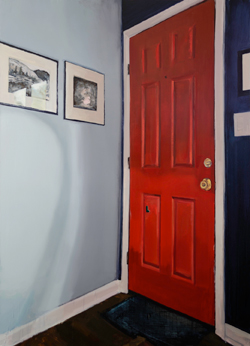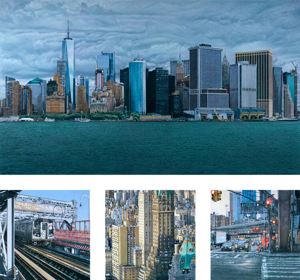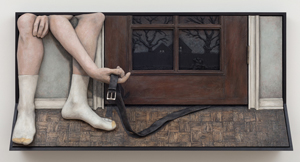Dreams of Home
John Haberin New York City
Don Eddy, Serena Stevens, and Dan Herschlein
Remember when New York was the city that never sleeps? It already seems so very long ago.
Now New Yorkers are more likely to feel stuck indoors, night and day. That does not make them any more at home. Don Eddy still evokes the displacement and disorientation that once passed for the everyday, before Covid-19. Yet he also finds their echo in nature and, of course, in paint. Tempted to flee for safety or sanity to an earlier life? Serena Stevens finds their echo, too, in her Iowa dreams. 
Dan Herschlein finds his echoes in your worst nightmares. No, Siri cannot wash and fold your clothes for you—or ask them in the morning to come to you. Be grateful, too, for the result might have a sinister life of its own. So it is with Herschlein and The Belt That Came In from the Night. By the end of the show he has built a wood-frame house to house those dreams, but be aware: a house is not always a home.
The cities that never sleep
Once the city carried on, whether one slept or not. So, too, did art and culture. Now it is restless, anxious New Yorkers who lie awake, while the city seems asleep in broad daylight—even its landmark architecture and, till barely a week ago, museums after Covid-19. And now, as galleries cautiously reopen, Don Eddy offers a reminder of its vitality and its dangers. With his mundane choices and photorealist detail, New York looks startlingly familiar, from its downtown skyline and bridges to its exit ramps and turnstiles. As a title has it, We Are Gotham.
We are, though, also wide awake with nowhere to go. Eddy's perspective leaves nowhere to stand, from a bus lane as the behemoths tunnel past to an aerial view of traffic on an avenue seemingly too wide ever to cross. Subways and station elevators seem too high tech ever to have existed, much less ridden in a system doomed to neglect. Street signs as identifiers are notably cut off. Intense lighting only adds to the detachment and the chill. Street lamps become blurred orbs as in a long exposure, reflecting off the metal siding of a bus or the streets as if off ice.
Seeing the show only as a "virtual tour" online may leave you thinking been there, done that. (See, art in person really does matter.) Photorealism, in turn, may have you thinking first of portraiture, as with Alfred Leslie, Philip Pearlstein, or Joan Semmel. Eddy's paintings may be less landscapes than prescriptions and portraits of a place to call your own. You may wish to stay up one night to check his observations for yourself, between their familiarity and their distance.
A title like Sleepless in Manhattan may suggest either a romantic comedy or just a bad night. It may also evoke a cafeteria at night or bedroom window at dawn for Edward Hopper and Hopper's New York—or, in art today, J. J. Manford. The sole human in the series, though, is in Paris, half hidden behind restaurant furnishing and chairs. (Quite a roamer in his insomnia, Eddy also includes Sleepless in Budapest.) Rather than a lonely diner on coffee to stay awake, the well-dressed man seems on familiar ground—perhaps the proprietor taking stock and closing up.  In the next panel he is gone, but the piled chairs only heighten the sense of human activity.
In the next panel he is gone, but the piled chairs only heighten the sense of human activity.
Eddy, who has appeared in a show of "Dialogues" between art and architecture, holds out alternatives, even as he offers glimpses of the familiar. They may span three or four canvases side by side, as with the restaurant views. A single canvas may also hang atop smaller ones adding up to its width. They may function as footnotes to the whole: are you aware of this detail or this history? You may not appreciate the Europe of It Turns to Gold, they say, until you step off a duly picturesque bend in a narrow street to enter gilded interiors.
The quaint old street also has its parked cars and motorcycles, and Eddy started his observations as early as 1970, with photos of vintage cars. The new paintings began four years ago, before the epidemic, when the city was still awake. The play of surface and detail, shadow and light, creature comforts and detachment, also continues in rural landscapes close to abstraction. The warmer colors of a riverbed peek through the cool blue and white of water. Both are churning. You better get some rest.
Like you never left
If you are a New Yorker after so many months without art, you wonder if you can ever leave your apartment again. If you are an artist, buffeted by finances, fellowships, and fate, you may wonder instead if you can ever return home. Thanks in fact to a fellowship, Serena Stevens is back where she grew up, in pursuit of her "Iowa Dream." Her show of that name has paintings as rich and comforting as they come. But are these her memories, her observations, or her dreams? She may be wondering herself if she has still to arrive.
They sure look like home, until you ask why. Her cat is still on the bed or, depending on the time frame, already at home, but people are nowhere to be seen. Photos or prints hang just inside the front door, although too blurred to pin down. A backyard table has hardly changed since a long summer evening, but darkness has descended to either side. Besides, it and a second table sit incongruously side by side, of standard-issue glass and wood, and fallen leaves cover both. They are set with a basket of stones.
They all have a striking immediacy, but then so do false memories and bad dreams. You may wish to reach out to touch the backyard table, thanks to her lush paint along the grain of its wood. You may wonder who will step out from behind a shower curtain—at roughly life size, like so much else. You may mistake the cherry red of the front door for the real thing, at least if you prefer the jpg in a "virtual tour" online. It looks so vivid that Stevens might well have set it right into the gallery wall, like an installation by Richard Artschwager or Robert Gober. She can paint more loosely as well, with stripes like ribbons, so that beds tilted close to the picture plane approach decorative abstraction.
There are signs, too, of transience and neglect. The door has a black mark that could pass for an accident or an exhibition's fallen dust—until you spot the white border for the illusion of three dimensions disturbing the picture plane and, for Stevens, one of ever so many barriers. An unmade bed is the spare, for visitors and not for family or cats. Suitcases pile so high and wide that Stevens could not conceivably need them all, not even to leave or to return home. If she has indeed made it, she has not unpacked enough to equip her studio table in another painting. A press release duly invokes the idea of "slow art," but here time itself is at issue.
Stevens has taken a while to cross America and back, but she was not exactly taking her time. As an artist, she did not have the luxury. She had already crossed the border to Illinois as an undergraduate, and she spent the next six years in Southern California, New Mexico, and the northeast. New England craft and austerity may color her treatment of the wood door. She takes the show's title from Arthur Russell, director of the Kitchen, a performance space here in New York. Still, her command of light and shadow gives her Iowa dream a specificity of time and place. They are her subject quite as much as the furniture and a secret weapon.
Naturally they can be spooky, too, on top of familiar or comforting. The shadows by the door sure look real, but I dare you to say what cast them, and a rocking chair seems caught in a web of shadow from something else again. A brighter light puts the suitcases under scrutiny, as if collecting evidence, while leaving some of them in shadow. A bolt of light pierces a street sign out front like a laser or a magic act, but the sign's shadow looks more like a parking meter. Something lights up the shower from within—perhaps the unseen presence of its bather. At least half the point of revisiting dreams is to look behind the curtain.
The horrors of home
Dan Herschlein shows a man, from the knees down, in an athletic crouch, reaching for a black belt that has seemingly slipped in under the door. The man has it firmly enough in hand, as if he had just picked it up from the floor. He seems at home there in his sweat socks, set against textured walls, molding, a wood-framed door, and a finely detailed parquet floor. He does, that is, unless the belt has risen into his hands, like a snake in the grass, after entering from a dark night with a menace of its own. One can see the night at an improbable angle through the door's glass panes, with bare trees, a mysterious glow on the horizon, two houses neither far nor near, and very possibly a dead body. There may be menace enough in a belt at that, with its overtones of abuse and corporal punishment.
Who here is the actor, and who is acted upon? The question amounts to the recipe for a horror movie, and you may have found yourself within one for "Dwelling." More belts lie here and there on the gallery floor, where you are unlikely to reach out and touch. Like a genre flick, Herschlein is playing to the rafters, even as he deconstructs the house. He is putting on a tawdry enough show, but he takes the question seriously. The man may be more vulnerable than you thought, without his pants, with holes in his socks, and with a hand on one knee that might not be his own.
Almost everyone here has both too many limbs and too few. For The Boneless One, a man with only a shroud for a head raises one hand, palm forward, and lowers the other in a nameless ritual.  But then the palm presses helplessly to the window, which seems about to slam shut upon the other hand—although not before a third hand rises up to touch it. Does that hand belong to a threat or to someone in desperation below, and what of a fourth hand tugging at the shroud? What of hands emerging from under the shirt of a doubled figure, its alter ego upside down as in a playing card and sharing the same headless neck? It is The Hourglass Figure, and time is running out.
But then the palm presses helplessly to the window, which seems about to slam shut upon the other hand—although not before a third hand rises up to touch it. Does that hand belong to a threat or to someone in desperation below, and what of a fourth hand tugging at the shroud? What of hands emerging from under the shirt of a doubled figure, its alter ego upside down as in a playing card and sharing the same headless neck? It is The Hourglass Figure, and time is running out.
Nothing is as it appears, including the media. The show opens with paintings, impressively tactile and realistic. That illusion, though, is an illusion. Herschlein works in relief, with wood, wax, putty, and resin. The belts on the gallery floor use the same materials apart from actual buckles, and the string tugging at a disembodied finger is fishing line. I can no longer say what is molded or painted.
A second room holds what looks like a full-blown installation, but forget about that, too. Herschlein prefers a stifling confinement. His wood-frame house has just enough space for yet another disembodied body—its collar a bed for soil rather than for a head. Do I have to say that two more hands reach into its pants where there should be feet? The illusion of an entire room in which to breathe comes from painted light. In one last painting, a hand in bed clutches more dirt and a worm.
Way too over the top? Totally, I fear, but then going too far is its theme—and its commentary on art and the movies. I might draw the line at that string tugging on fingers rather like sausage casing. The meal on the table, of mashed potatoes and generic meat, looks no more inviting. And Herschlein still has his domestic realism. The bed in that final painting has the rural charm of a patterned quilt, even if its stars alternate with bare, dark trees.

Don Eddy ran at Nancy Hoffman through September 4, 2020, Serena Stevens at Postmasters through September 12, and Dan Herschlein at JTT through October 18.




